Table of Contents
Navy bean soup is a comforting, protein-rich dish that has been enjoyed for generations. Known for its creamy texture and rich flavor, this soup has roots in American cuisine, particularly in traditional home cooking and military rations. It gained historical significance through the famous U.S. Senate Bean Soup, a staple on the Senate dining menu since the early 1900s.
Packed with fiber, protein, and essential nutrients, navy bean soup is not only delicious but also a heart-healthy meal option. Whether made with smoky ham for a classic touch or customized into a vegetarian delight, it remains a versatile and nourishing choice.
Nutritional Profile of Navy Beans
Navy beans are a powerhouse of nutrition, making them an excellent ingredient for a hearty and healthy soup. These small, white beans are packed with essential macronutrients, including high-quality plant-based protein, fiber, and complex carbohydrates. One cup of cooked navy beans provides about 15 grams of protein and 19 grams of fiber, promoting satiety and digestive health.
Rich in micronutrients, navy beans are an excellent source of B vitamins (especially folate and thiamine), iron, magnesium, and manganese. Folate is crucial for cell growth and development, while iron supports oxygen transport in the blood. Magnesium contributes to muscle and nerve function, making navy beans an excellent choice for overall well-being.
The health benefits of navy beans extend beyond basic nutrition. Their high fiber content helps regulate blood sugar levels, making them a diabetes-friendly food. Additionally, their ability to lower bad cholesterol (LDL) contributes to heart health, reducing the risk of cardiovascular diseases. Because of their slow-digesting carbohydrates, they also support weight management, keeping you full for longer.
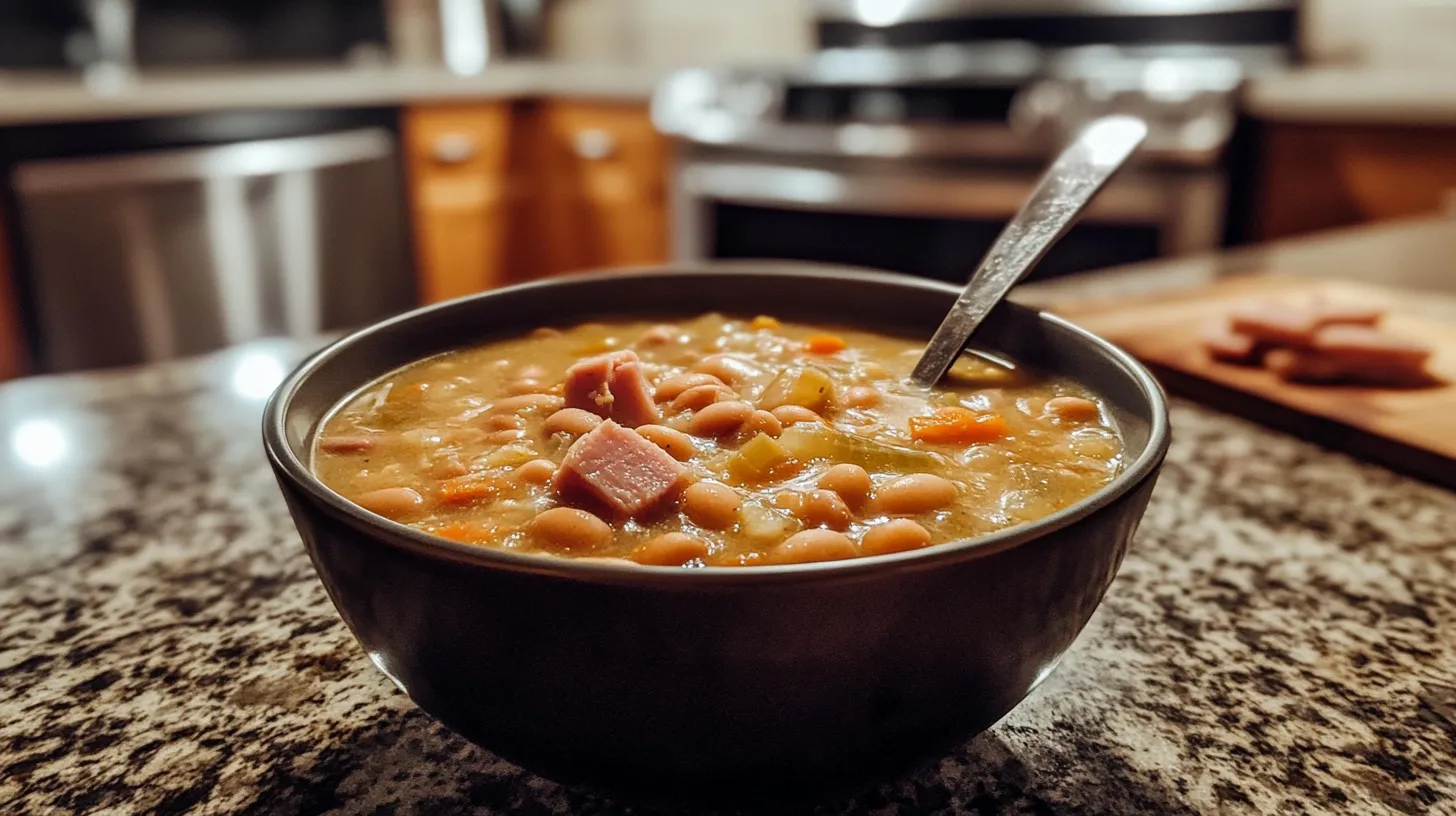
Traditional Variations of Navy Bean Soup
Navy bean soup has evolved across different regions and cultures, with each variation adding its own unique twist. While the classic American version is slow-cooked with ham for a rich, smoky flavor, there are several other traditional adaptations that highlight different ingredients and cooking styles.
One of the most famous variations is the U.S. Senate Bean Soup, which has been served in the Senate dining hall for over a century. This version is made with navy beans, ham hock, butter, and a simple mix of onions and seasoning, keeping the flavors traditional and hearty.
For those looking for a meat-free option, the vegetarian and vegan versions of navy bean soup use plant-based ingredients to enhance depth of flavor. Smoked paprika or liquid smoke can mimic the richness of ham, while vegetables like carrots, celery, and tomatoes provide natural sweetness. Some recipes also incorporate coconut milk or cashew cream for added creaminess.
In Southern-style cooking, spicy navy bean soup is a popular choice, featuring andouille sausage, cayenne pepper, and garlic for extra heat. Meanwhile, Mediterranean-inspired versions often include olive oil, rosemary, and sun-dried tomatoes for a lighter yet flavorful take.
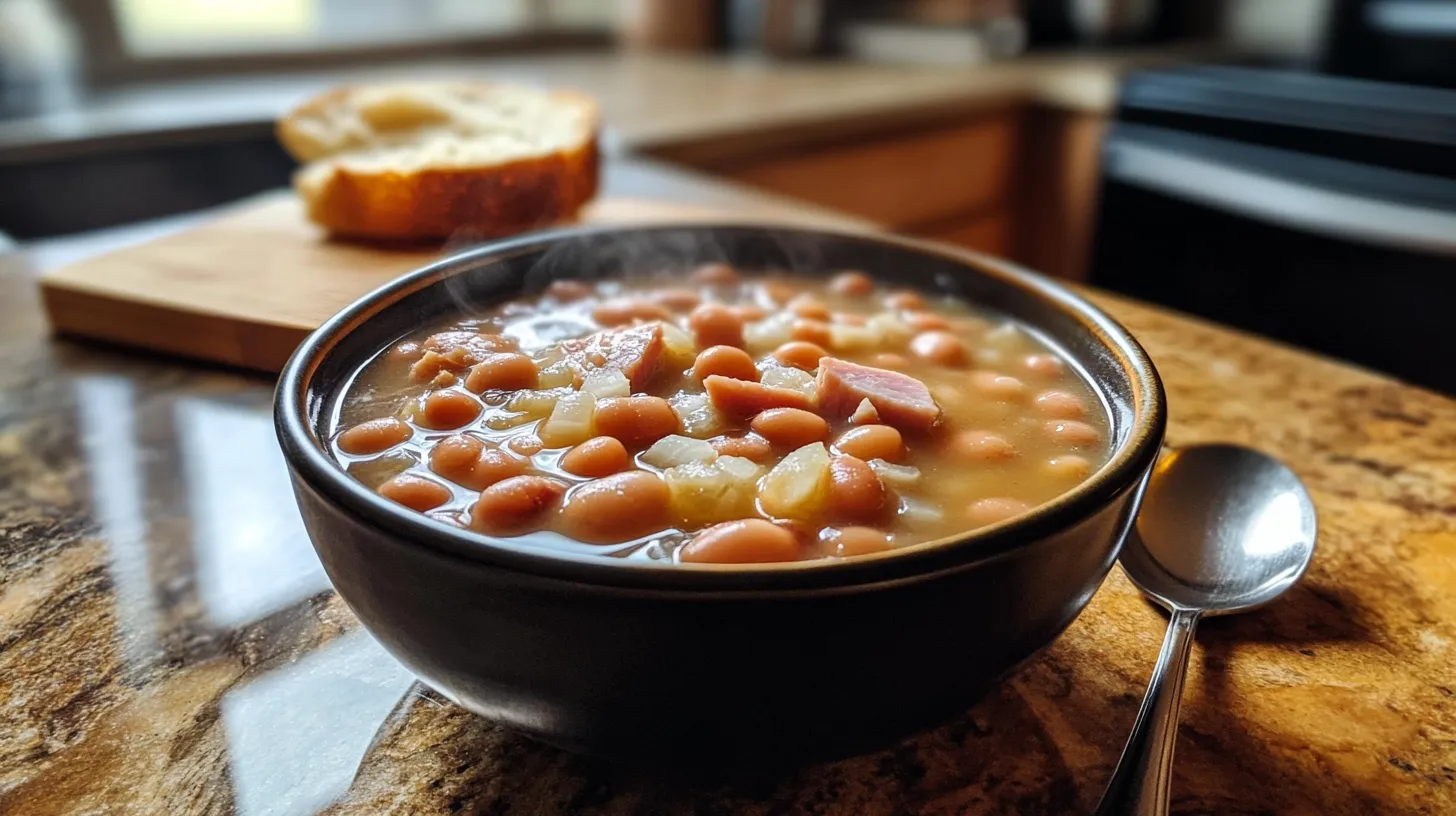
Cooking Techniques and Tips
Making navy bean soup from scratch requires attention to key cooking techniques that enhance flavor, texture, and consistency. One of the first decisions is whether to use dried or canned navy beans. Dried beans need to be soaked overnight or quick-soaked before cooking to reduce cooking time and improve digestibility. Canned beans, on the other hand, are convenient and require minimal preparation but should be rinsed to remove excess sodium.
To develop a deep, savory flavor, the sautéing process is crucial. Cooking onions, garlic, and aromatic vegetables in olive oil or butter before adding the beans and broth enhances the soup’s richness. For a smokier taste, using a ham hock, smoked turkey leg, or bacon can infuse the broth with an extra depth of flavor.
Achieving the right consistency is another important step. If you prefer a creamy texture, you can blend a portion of the soup and mix it back into the pot. Alternatively, for a chunkier version, mashing some of the beans with a spoon helps thicken the soup without blending.
Seasoning is essential to bringing out the best flavors. Bay leaves, thyme, smoked paprika, and a dash of vinegar or lemon juice can balance the richness of the soup. Cooking it low and slow allows the ingredients to meld together, creating a deeper and more satisfying taste.
Navy Bean Soup: Nutrition Facts & Health Benefits
Navy bean soup is not only a flavorful comfort food but also a nutritional powerhouse packed with protein, fiber, and essential vitamins and minerals. Each serving provides a well-balanced combination of macronutrients and micronutrients that support overall health.
Nutritional Breakdown (Per 1 Cup Serving)
| Nutrient | Amount |
|---|---|
| Calories | 220-250 kcal |
| Protein | 15g |
| Carbohydrates | 35g |
| Fiber | 12g |
| Sugar | 2g |
| Fat | 4g |
| Saturated Fat | 1g |
| Cholesterol | 10mg |
| Sodium | 600-800mg (varies by broth) |
| Iron | 3mg (15% DV) |
| Magnesium | 60mg (15% DV) |
| Folate (B9) | 90mcg (22% DV) |
| Potassium | 600mg (13% DV) |
DV = Daily Value based on a 2,000-calorie diet. Values may vary depending on ingredients used.
Serving Suggestions and Pairings
Navy bean soup is a hearty dish on its own, but pairing it with complementary sides and garnishes can elevate the meal. Classic accompaniments include warm cornbread, crusty artisan bread, or buttery biscuits, which help soak up the flavorful broth. For a lighter option, a fresh green salad with a tangy vinaigrette balances the richness of the soup.
Beverage pairings can also enhance the dining experience. A full-bodied white wine like Chardonnay or a light red wine such as Pinot Noir pairs well with the smoky, savory flavors of the soup. If you prefer non-alcoholic options, herbal teas, lemonade, or a simple iced tea can complement the dish.
For a visually appealing and flavorful finish, consider garnishes like freshly chopped parsley, green onions, or a sprinkle of grated Parmesan cheese. A drizzle of olive oil or a dollop of sour cream can add extra richness, while a pinch of red pepper flakes provides a subtle heat.
If serving for a larger meal, navy bean soup pairs well with grilled vegetables, roasted potatoes, or a side of steamed greens for a balanced plate. Whether enjoyed as a comforting lunch or a filling dinner, these additions make the meal even more satisfying.
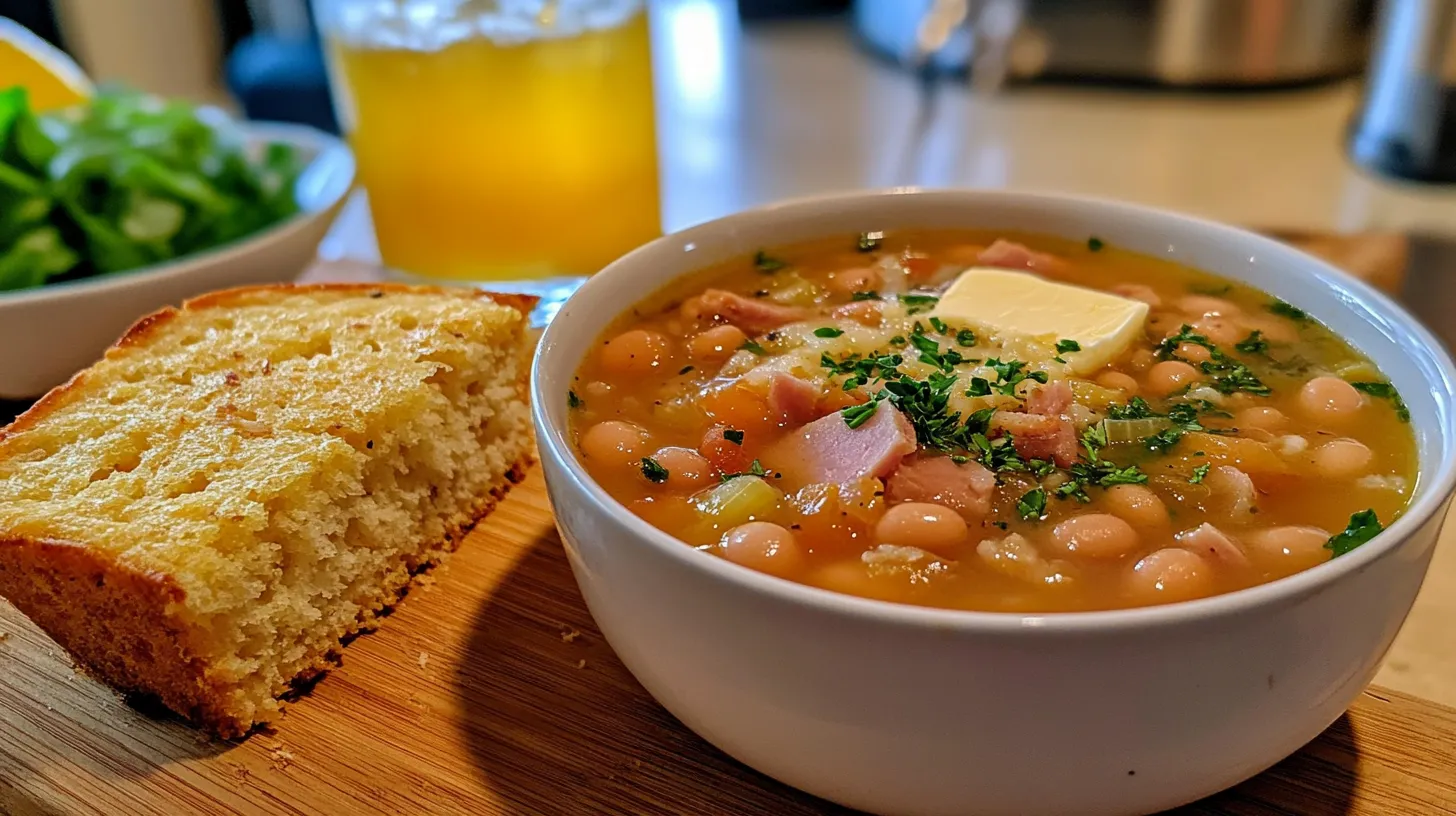
Incorporating Navy Bean Soup into a Balanced Diet
Navy bean soup is a nutrient-dense dish that fits well into a balanced diet, offering a combination of protein, fiber, and essential vitamins. Whether you’re following a high-protein diet, plant-based meal plan, or simply aiming for healthier eating habits, this soup can be an excellent addition to your weekly menu.
For those watching their calorie intake, portion control is key. A standard serving provides a satisfying amount of protein and fiber, which helps keep you full for longer. If you want a lower-calorie version, using lean proteins like turkey instead of ham or reducing added fats can make the soup lighter while still keeping it flavorful.
This soup is also diabetes-friendly due to its low glycemic index. The fiber in navy beans helps regulate blood sugar levels by slowing down digestion and preventing spikes in glucose. Adding leafy greens or extra vegetables increases its nutrient content without significantly changing the calorie count.
If you’re meal planning, navy bean soup is a great batch-cooking option. It stores well in the refrigerator for up to five days and freezes beautifully for up to three months. You can easily reheat it for a quick and nutritious meal, making it a time-saving choice for busy schedules.
Print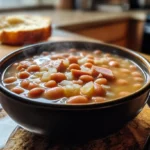
Navy Bean Soup Recipe
- Total Time: 2 hours 15 minutes
- Yield: 6 people 1x
Description
This Navy Bean Soup is a hearty, comforting dish packed with creamy navy beans, tender vegetables, and smoky ham. Perfect for a chilly day, this soup is slow-simmered to develop rich flavors, making it an easy and budget-friendly meal for the whole family.
Ingredients
- 1 lb dried navy beans (rinsed and soaked overnight)
- 1 tbsp olive oil
- 1 medium onion (chopped)
- 2 carrots (diced)
- 2 celery stalks (diced)
- 3 garlic cloves (minced)
- 1 smoked ham hock or 1 cup diced ham
- 6 cups chicken or vegetable broth
- 2 bay leaves
- 1 tsp dried thyme
- 1/2 tsp black pepper
- 1/2 tsp salt (adjust to taste)
- 1 tbsp apple cider vinegar
- Fresh parsley for garnish
Instructions
Prepare the Ingredients
- Step 1: Prepare the Ingredients Before cooking, rinse and soak the navy beans overnight to soften them and reduce cooking time. Drain and set them aside. Chop all vegetables, including the onion, carrots, and celery, ensuring they are cut into small, even pieces for uniform cooking. Mince the garlic finely. If using a smoked ham hock, inspect it for any tough outer pieces and trim if necessary. These steps will ensure a smooth cooking process when you start assembling the soup.
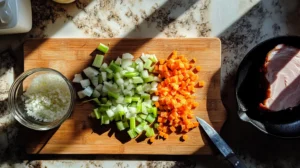
Sauté the Vegetables and Build Flavor
- Step 2: Sauté the Vegetables and Build Flavor Heat a large pot or Dutch oven over medium heat and add the olive oil. Once the oil is warm, add the chopped onion, carrots, and celery, stirring occasionally for about five minutes until they become tender and aromatic. Then, add the minced garlic and cook for an additional minute, allowing its fragrance to develop. Stir in the thyme, black pepper, and a pinch of salt, coating the vegetables with the seasoning to enhance the soup's depth of flavor.
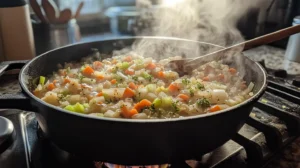
Simmer the Soup and Cook the Beans
- Step 3: Simmer the Soup and Cook the Beans Add the drained navy beans to the pot, followed by the smoked ham hock or diced ham. Pour in the broth, ensuring that all ingredients are well-submerged. Drop in the bay leaves, give everything a good stir, and bring the soup to a gentle boil. Once boiling, reduce the heat to low, cover the pot, and let it simmer for about 1.5 to 2 hours. Stir occasionally, checking the beans for tenderness. The soup will gradually thicken as the beans break down, creating a creamy and rich texture.

Finish and Serve
- Step 4: Finish and Serve Once the beans are fully tender, remove the ham hock from the pot. Shred the meat from the bone, discarding any excess fat or tough parts, and return the shredded meat to the soup. Stir in the apple cider vinegar to brighten the flavors, and adjust the seasoning with additional salt and pepper if needed. Remove the bay leaves and ladle the hot soup into bowls. Garnish with fresh parsley and serve with crusty bread or cornbread for a complete, satisfying meal.
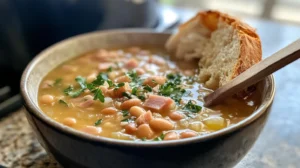
Notes
- Storage: Store leftovers in an airtight container in the fridge for up to 4 days or freeze for up to 3 months.
- Variations: Add diced potatoes or extra veggies for a heartier soup.
- Serving Suggestions: Pair with crusty bread or cornbread for a complete meal.
- Prep Time: 15 minutes
- Cook Time: 2 hours
- Category: Main Course, Soup
- Cuisine: American
Nutrition
- Calories: 220
FAQ: Navy Bean Soup Recipe
u003cstrongu003eHow do I thicken navy bean soup?u003c/strongu003e
You can thicken navy bean soup by blending a portion of the beans and broth, then mixing it back into the pot. Another method is mashing some beans with a spoon. Adding a small amount of cornstarch slurry or simmering longer will also help achieve a thicker consistency.
u003cstrongu003eCan I make navy bean soup without soaking the beans?u003c/strongu003e
Yes, but it will take longer to cook. If you don’t soak dried navy beans, expect a longer cooking time (around 2-3 hours). Using a pressure cooker or Instant Pot can significantly reduce the cooking time without soaking.
u003cstrongu003eWhat can I use instead of ham for a vegetarian version?u003c/strongu003e
For a vegetarian navy bean soup, replace ham with smoked paprika, liquid smoke, or umami-rich ingredients like miso paste, soy sauce, or fire-roasted tomatoes. Adding extra vegetables and herbs enhances the flavor.
u003cstrongu003eCan I freeze navy bean soup?u003c/strongu003e
Yes, navy bean soup freezes well for up to three months. Let it cool completely before storing it in airtight containers. When reheating, add a little broth or water if the soup has thickened too much.
Conclusion
Navy bean soup is a hearty, nutritious dish that blends tradition with great taste. Whether made with ham for a smoky depth or a vegetarian twist, it offers protein, fiber, and essential nutrients.
Its rich history, simple preparation, and health benefits make it a staple in many kitchens. With proper seasoning and cooking techniques, it transforms into a flavorful and comforting meal.
Easy to store and reheat, navy bean soup is a perfect addition to meal plans. Whether for warmth in winter or a nutritious year-round dish, it’s a satisfying choice for any table.

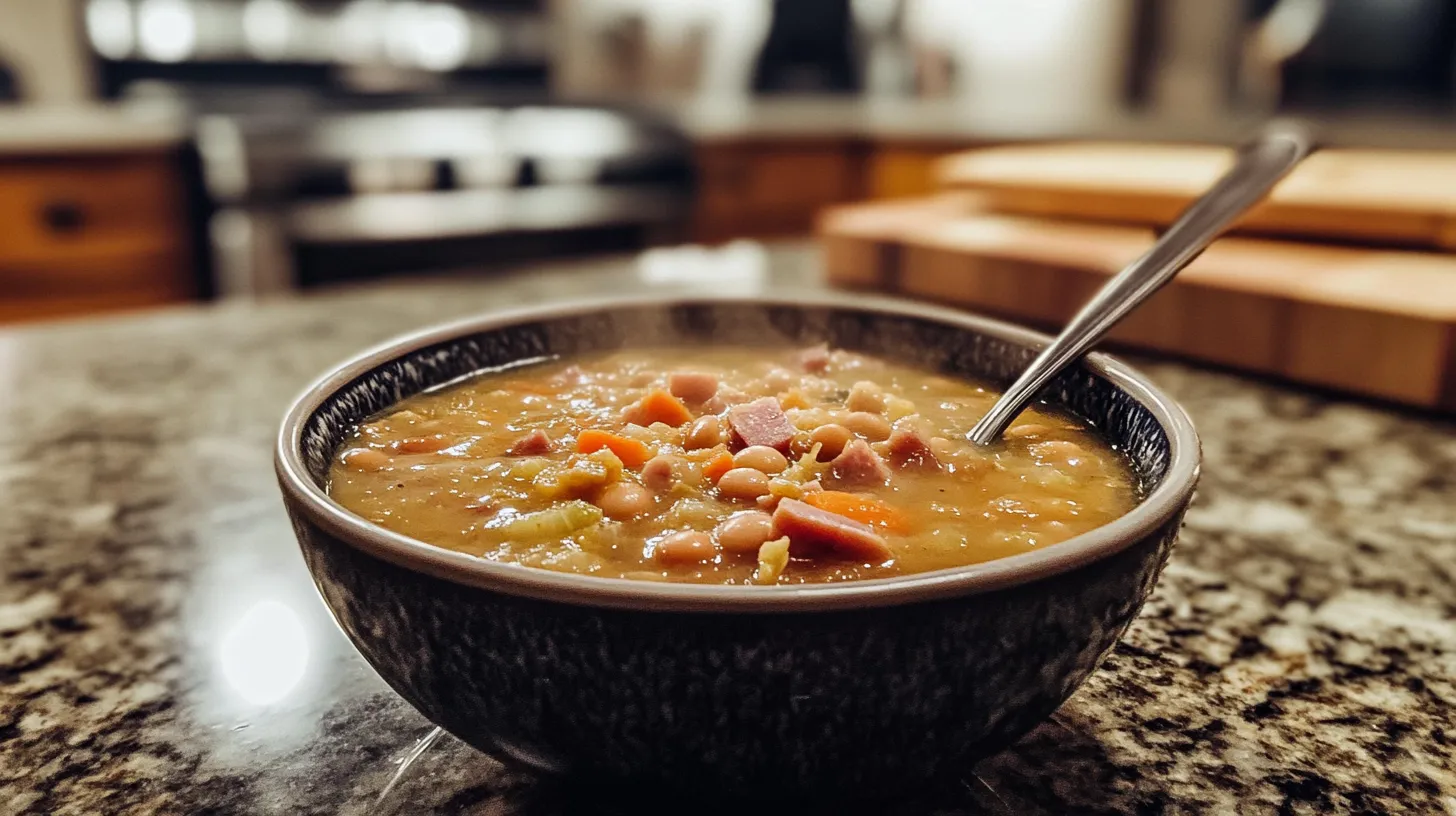

This recipe is both simple and delicious. I added just a dash of cayenne pepper, perfection! I also used a 16-bean mix, which I preferred. Thank you for sharing this recipe